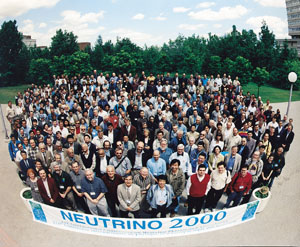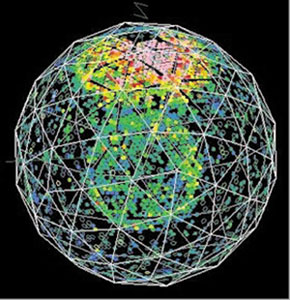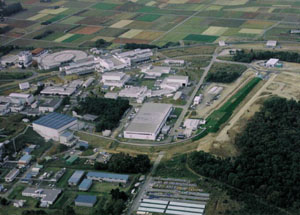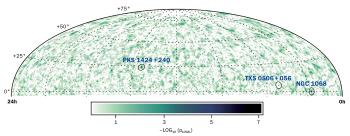Neutrinos are always interesting and frequently controversial. The biennial neutrino physics meeting, held this year in Sudbury, Canada, welcomed a major new neutrino detector and showed how the complex neutrino picture of the universe is slowly coming together. Piero Zucchelli reports.

It is difficult to explain what the biennial neutrino conferences mean for the neutrino physics community. Every two years, hundreds of scientists from all over the world meet to update and compare results, conclusions, opinions, claims and contentions.
Neutrino physics is different from any other field due to the variety of experiments, techniques, measurements, approaches, theories and prejudices associated with it.
Neutrino physics today involves many different fields – the detection of remnant neutrinos from the Big Bang; galactic neutrinos at extreme energies; neutrinos from supernovae, the Sun, the Earth’s atmosphere and emitted from the Earth; artificial neutrinos produced from accelerators and nuclear reactors; and laboratory neutrinos from tabletop sources.
These experiments, spanning the 0.1 eV-1 PeV (1000 TeV or 1015 eV) energy region and providing information on the same particle, give a good idea of the spirit of the conference – a scientific bazaar where a cosmologist’s opinion is confronted with that of a solid-state physicist, and a 50 000 t Cherenkov detector’s results have to be understood in the light of the claims from a 10 kg calorimeter. Neutrino 2000, the 19th iteration of the biennial neutrino forum, took place in Sudbury, Ontario.
According to the results presented, the only possible conclusion is that neutrinos have mass. The solar neutrino deficit, the atmospheric neutrino oscillation pattern and the Los Alamos Neutrino Detector (LSND) claim in the region of cosmological interest have been confirmed and reinforced.
However, the interpretation of the results is ambiguous and the emergence of a unique picture strongly depends on experimental confirmation and improvements. A wide ongoing programme aims to improve our current experimental knowledge – new solar neutrino experiments such as SNO and Borexino, long-baseline programmes at Fermilab at CERN addressing the atmospheric neutrino signal, and MiniBoone on the verification of the LSND claim.
A worldwide programme for the study of a neutrino factory is also challenging the unprecedented possibility of precision measurements on neutrinos and is advancing rapidly to overcome the difficulties of exploitation.

The Sudbury observatory
In addition to the beautiful Canadian environment and the conference itself, interest was focused on the Sudbury Neutrino Observatory (SNO), a 1 kt heavy-water detector that has been in operation since September 1999. SNO has the unique ability to be able to say if the solar neutrino problem – a neutrino deficit with respect to the theoretical predictions and now observed by a variety of experiments – is indeed due to neutrino oscillations. (Classically, the different neutrino types – electron, muon and tau – lead separate lives. However, with a mass these species can “oscillate” or transform into each other.)
To achieve this goal at SNO meant solving formidable technological problems – the deepest observatory in the world, shielded by 2000 m of rock in an active nickel mine, with a cosmic ray reaching the detector once every 20 min. The environmental conditions are particularly critical, and the entire laboratory has been constructed by transporting single components down a vertical elevator and a 1.3 km horizontal tunnel. The SNO is a “ship in a bottle”.
SNO has an unprecedented purity for a large-scale detector – the purification system extracts daily seven atoms of radon for every ton of heavy water. To achieve this, strict precautions are taken. The laboratory is completely shielded from the still-active mine environment (blasting occurs in neighbouring tunnels), and different levels of cleanliness and dust purity allow the inner core to be a class 10 000 clean room (fewer than 10 000 dust particles per cubic foot).
Since everything reaching the detector goes through the mine, the major source of radon contamination comes from the transfer of material. For example, even Neutrino 2000 visitors in special clothing meant a significant effort to restore normal purity conditions.
SNO uses heavy water – a very precious liquid. However, Canada is the major world producer. Heavy water (produced for nuclear power plants) is usually extracted from freshwater lakes.

Simultaneous detection
The SNO experiment has demonstrated that the design goals have been achieved, and solar neutrino interactions above 2 MeV are indeed measured – less than one per hour – with the expected backgrounds. However, no quantitative statement on the solar neutrino problem was made by SNO at the conference, and scientists are waiting for additional data and improvements that will make SNO the only experiment capable of also detecting the interactions from muon or tau neutrinos coming from the Sun. Since only electron neutrinos are produced in solar nuclear reactions, simultaneous detection of an electron neutrino deficit and a muon or tau neutrino excess would be the final proof that electron neutrinos oscillate.
The conference, as usual, provided new and exciting results. For the first time in such a meeting, long-baseline data were presented. In the K2K project, artificial neutrinos from the Japanese KEK laboratory are detected 250 km away in the Superkamiokande 50 000 t underground detector.
The observed rate is compared with predictions extrapolated from the interaction rate registered by detectors near the source to cross-check, in an independent way, the result claimed by Superkamiokande based on “natural” neutrinos produced by cosmic-ray interactions in the atmosphere.
As with the solar neutrino effect, a neutrino deficit would imply neutrino disappearance, and thus an indication of neutrino oscillation. Still, the meagre data so far (17 events observed while 29 were expected; September p8) did not allow K2K to claim a deficit that would confirm the atmospheric neutrino oscillation signal, but data will naturally increase in the coming years.
Superkamiokande is also able to detect solar neutrinos, and on this subject data were meaningful, excluding possible hypotheses on the solar neutrino problem. In particular, they were able to collect 15 000 solar neutrino interactions with an improved signal-to-noise ratio and lower energy threshold (5 MeV).
These data could disfavour the simple hypothesis of neutrino oscillation in vacuum (space), and instead point more directly to additional oscillations as the neutrinos traverse the Sun, significantly refining the known oscillation parameters.
Limits on neutrino mass?
The neutrino oscillation phenomenon cannot occur if neutrinos are massless. On the contrary, if neutrinos are massive, it is possible that they oscillate. The oscillation is such that not all neutrino oscillation experiments could actually observe it: this depends on a few parameters, such as the neutrino flavour (electron, muon or tau) they can detect, the neutrino flavour emitted from the source, the distance from the neutrino source and the energy of the neutrinos.
Many experiments are therefore currently looking for neutrino masses but are not observing a positive signal, without being in contradiction with the fact that neutrinos have mass and can be seen to oscillate under other conditions. Among these are the CHORUS and NOMAD experiments at CERN, which are currently exploring the oscillation parameters with a sensitivity higher than any other experiment (their new results are about 1000 times as sensitive as Superkamiokande).
All of these experiments are nevertheless contributing to our understanding of neutrino properties. CHOOZ and Palo Verde, for example, have measured the neutrino emission from nuclear power plants but did not observe any oscillation phenomenon. However, their results are crucial, showing that the atmospheric neutrino oscillation claimed by Superkamiokande does not take place between electron neutrinos and muon neutrinos, but between muon neutrinos and something else.
Another group of experiments is pursuing a different strategy – to detect the neutrino masses directly, that is without assuming the oscillation hypothesis but directly “weighing” their mass, as has been done for all other known particles.
Unfortunately, neutrino masses are extremely small, and the current experimental sensitivity of the Mainz and Troitsk experiments allows us to say that the electron neutrino mass is less than a few electronvolts. This is again compatible with all neutrino masses currently claimed (even with the massless neutrino hypothesis) but does not rely at all on the oscillation hypothesis.
Neutrino astrophysics and cosmology
No less important were the neutrino-related conclusions from astrophysics and cosmology. For the first time, supernova modelling was able to describe the stellar explosion mechanism, which is crucial to understand the time distribution of the emitted neutrinos.
At the same time, cosmological measurements are constraining more and more the way neutrinos can be distributed in the universe, pointing to a significant dark matter contribution by neutrinos of a mass of about 1 eV.
Neutrino scientists are eagerly awaiting the next nearby supernova explosion. The 1987 event, were it to happen today, would yield far more data on neutrino properties due to detector improvements. The supernova rate in our galaxy is about three per century, so one of the next neutrino meetings will be more interesting than ever.








